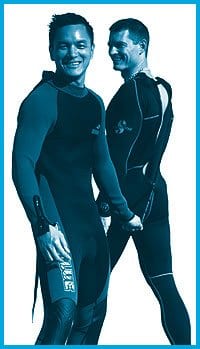When members of the US navy first strapped on oxygen tanks and slipped into massive airtight suits to walk on the ocean floor, they had no idea they were inventing the perfect queer sport. But consider the evidence.
The first rule of scuba diving is that you do it with a buddy. You pull on rubber, get wet and then you and your buddy go down and blow. Suspended as you are in a watery, weightless world with no objective other than to seek out and admire fleshy, good-looking things, the sport demands no great athletic ability or coordination, though it’s helpful to have an affinity for dark, wet and sexually-charged environments – especially during spawning season.
And the athletic uniform is to die for: skin-tight neoprene or spandex suit, possibly accessorized with a bright fuchsia flipper, mask and snorkel ensemble.
After meeting veteran diver David Bress, Gary Speedie took up the sport just two months later. During their 11 years together since – as dive buddies and a couple – they’ve heard all the jokes about their water sport of choice, mostly from other gay divers.
“Actually, we really dive because we love to see each other in spandex,” quips Speedie.
Yet the sport is intensely sensual. I first slipped a regulator into my mouth in Andros, Bahamas, at a resort made famous by former prime minister Pierre Trudeau who honeymooned there with Maggie. On dive adventures since – to Key West, the Great Barrier Reef after the most recent Gay Games in Australia and the northern tip of Vancouver Island – I’ve swum with porpoises, seals, rare Green turtles, reef sharks and, on one mind-blowing occasion, 50 very big and very wild Pacific white-sided dolphins.
But that’s not half the attraction. Diving submerges you in a libidinous world of breast-like hills of corral raging with lacey and racy invertebrate life, sucking mouths and pulsating filament tongues everywhere; sea cucumbers stiffening to the length of an arm at the slightest touch; he-chitons spewing sticky streams of semen up to five metres away.
Imagine sharing this erotic charge with a same-sex dive buddy, linking arms or holding hands, pointing out such fabulous sights while copping underwater feels of erect body parts. Now it’s possible.
A group of six Toronto area divers met at the International Gay And Lesbian Scuba Jamboree three years ago, connected, threw a hell of a party and came home to form the Toronto Rainbow Reef Rangers dive club, dubbed TR-3. The club organizes a major hot-destination dive each year – this September it’s to Cozumel – as well as a half-dozen dives to such local sights as Kingston, Torbermory and Pelee Island.
They maintain strong ties to Diving For Life, an American-based not-for-profit organization, which organizes the annual jamboree where they met. Bress, a member of TR-3, is currently the president of Diving For Life, which raises money for gay and lesbian charities. He negotiates group discounts for the 120 to 150 divers the jamboree attracts to such locales as Bonaire, Curacao and the Cayman Islands. Rather than returning the savings to the individual diver, Diving For Life passes the money onto participating dive clubs which then donate the money to local charities. Since it started in 1992, Diving For Life has raised almost $300,000 for queer charities and, since its inception two years ago, TR-3 has raised some $6,700 for Casey House.
TR-3 now has 30 members and is actively recruiting. The club’s big focus now is getting women into the club and increasing the overall membership, really for no other reason than to share their love of the nautical.
“About half the members are in couples,” says club treasurer Eric Johnson. “The focus really is on diving.”
But member Tim Moseley, who dives with his partner Jung Dai, emphasizes that the sport is a great way to meet people and to share a passion.
“Our members range in age from 26 to 62. Virtually no matter what your age, personality or athletic ability, you can dive,” says Dai. “It brings together a diverse group of people you wouldn’t meet in any other way. You’d think it would appeal to the thrill-seeker, but that’s not the case. You get people after the adrenaline rush, but you get laid-back types. You get the safe and cautious types. You get all kinds.”
Says Johnson: “Diving is part of the Caribbean experience and of course, going to the Caribbean is a very gay thing to do. We know there are a lot of gay and lesbian divers out there, but often they don’t know our club exists.”
* TR-3 will host a discover scuba night on Thu, Oct 2 at 6:30pm at Jarvis Collegiate pool. For $10, you can try on the equipment and try diving under the watchful eye of a dive instructor. To sign up, e-mail Tim Moseley tmoseley@sympatico.ca with your name, phone number and e-mail address. Cost of joining TR-3 is $75 for the first year and $25 annually after than. Scuba courses range from $250 to $500, while dive trips range from $10 for a tank of air for an off-shore dive to an average $2,500 for Caribbean trips.
* For more information on TR-3 check out their website at www.candog.com/trrr.

 Why you can trust Xtra
Why you can trust Xtra


